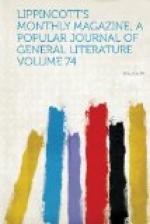The experts for the defence asserted that the convulsion of Saturday could not have been caused by strychnia or other known poison; that although the symptoms of the later attacks resembled those of tartar emetic poisoning, they were not identical with those usually produced by that drug; and that it was exceedingly improbable that these attacks were due to the poison named, because obvious natural causes for them existed.[24]
The impropriety and total insufficiency of our methods of criminal prosecutions were very strongly shown by this trial. One member of the jury could barely write his name, and not more than one or two of them were in the lowest sense of the term educated; no record of the testimony was kept by the court, and none, except in the very beginning, by the jury, who must therefore have been guided chiefly by impressions, lawyers’ speeches or newspaper records; the feeling amongst the populace, with whom the jurymen freely mingled, was so bitter that one of the experts was barred out of his lodgings at ten o’clock at night, openly because he was for the defence of Mrs. Wharton; the newspaper which circulated most largely in the place misrepresented the testimony, and devoted its columns to scurrilous attacks upon the integrity and professional ability of the medical witnesses for the defence. Yet under these influences, mazed and confused by the subtleties and partial statements of the lawyers, these twelve honest but ignorant men were called upon to decide between physicians offering precisely opposite opinions. It is well when this so-called administration of justice ends as a monstrous farce and not as a tragedy.
The conduct of the Wharton-Van Ness trial would have been far different if the expert testimony had been what it ought to have been. If the excretions of Mr. Van Ness had been put in the hands of a properly-qualified chemist, by finding the metal antimony or by proving its absence he would at once have settled the case. As it is, there is no proper evidence of the guilt of Mrs. Wharton. The probabilities are in favor of her innocence, because the symptoms were certainly widely divergent from those induced by poison, if not, as I believe, absolutely incompatible with poisoning. The medical gentlemen who attended Mr. Van Ness, by destroying all the evidence, have made a just conviction and an absolute proving of innocence equally impossible.
If it were necessary, further illustrations of the deficiencies of our criminal processes could be detailed. Some little time since, upon the chemical evidence of Professor Aiken, a poor colored woman was hung in Anne Arundel county, Maryland. She died protesting her innocence, and the general impression appears to be now that she did not commit the crime. A prominent member of the Maryland Bar told me recently of a case tried in that State, in which the accused, as he stated, certainly did kill the deceased with arsenic, yet in which, by showing the insufficiency of Professor Aiken’s analysis of the stomach, he obtained the acquittal of the prisoner.




